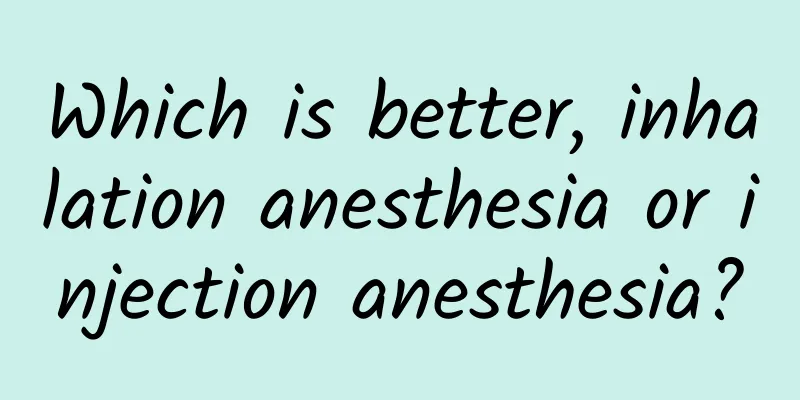Which is better, inhalation anesthesia or injection anesthesia?

|
Inhalation anesthesia and injection anesthesia are both common methods used in anesthesia surgery. They each have their own advantages and disadvantages. There is no definite answer as to which method is better. The choice of which method is better depends on the specific situation and surgical requirements. This article will discuss the advantages and disadvantages of inhalation anesthesia and injection anesthesia, as well as their usage conditions in different situations. Inhalation anesthesia : Inhalation anesthesia is a method of delivering anesthetic drugs into the patient's lungs through breathing, and then transporting them to the brain through the alveoli and blood to achieve general anesthesia. Inhalation anesthesia usually uses anesthetic gases or volatile anesthetic drugs, allowing patients to inhale or absorb these drugs through breathing, thereby producing the effect of general anesthesia. advantage: 1. Rapid onset of effect: Inhalation anesthesia can control the anesthesia level by adjusting the concentration and flow rate of the anesthetic gas. The effect usually appears quickly and the surgical operation can start quickly. 2. Avoid venipuncture: venipuncture is not required. It is more suitable and convenient for patients who are not suitable for intravenous injection or teenagers and children who are afraid of injections. shortcoming: 1. Respiratory tract irritation: Some patients may experience respiratory tract irritation from anesthetic gases, causing coughing or discomfort. 2. Contraindications: Some specific diseases or conditions may not be suitable for the use of inhalation anesthesia, such as patients with respiratory problems or lung diseases. 3. There is no very precise concentration monitoring: the depth of anesthesia is often adjusted by changing the concentration of anesthetic gases or volatile anesthetic drugs, and there is no very accurate measurement tool to monitor the depth in real time. Injection anesthesia : Injection anesthesia is a method of achieving anesthesia by injecting anesthetic drugs into the body. Injection anesthesia usually includes two methods: intravenous injection or intramuscular injection. Anesthetic drugs can directly enter the blood circulation system and quickly produce general anesthesia. advantage: 1. Stable effect: Injection of anesthetic drugs can provide stable anesthetic effect and better control the depth of anesthesia. It can also control the concentration and the time of awakening. 2. Rapid effect: Injectable anesthesia can quickly enter the blood circulation and take effect quickly. 3. Wide range of applications: Suitable for a variety of surgeries and patient conditions, including those who are not suitable for inhalation anesthesia. shortcoming: 1. Venipuncture: Venipuncture is required, which may not be popular with some patients who do not like or are afraid of needles. 2. Metabolic process: Some injected anesthetic drugs need to be metabolized by the liver, which requires high liver function. Selection method and considerations : Patient health status: Assess the patient's overall health status, including cardiovascular system, respiratory system, liver and kidney function, etc. Consider whether the patient is allergic to a particular anesthetic drug. Type and timing of surgery: Depending on the type of surgery (general, regional or local anesthesia) and duration, the more appropriate anesthesia method will be chosen. For situations requiring longer surgical times, a more stable and controlled depth of anesthesia, such as injectable anesthesia, may be necessary. Anesthesiologist recommends: According to the advice of professional anesthesiologists, they will recommend the most suitable anesthesia method based on their experience and the patient's condition. The medical team needs to evaluate the individual differences and surgical characteristics of the patient and develop a personalized anesthesia plan. When is inhalation anesthesia better ? Prolonged surgery: For situations that require a longer surgical time, inhalation anesthesia is often better at maintaining the depth and stability of anesthesia. Type of surgery: Certain types of surgery may require a deeper depth of anesthesia. Inhalation anesthesia can provide a wider range of anesthesia effects, including general anesthesia and deep anesthesia. Anesthesia depth requirements: For surgeries that require more precise control of anesthesia depth, this can be achieved by adjusting the concentration of inhalation anesthesia within a certain range. Sensitive reactions to medications: Some patients may have allergic reactions or adverse reactions to injected anesthetics, and inhaled anesthesia may be a safer option. Patients with poor liver and kidney function: Volatile anesthetics have a low metabolic rate in the body and do not increase the burden on the liver and kidneys. When is injection anesthesia better ? Local anesthesia for the surgical area is ineffective or unfeasible: For some surgical areas, local anesthesia may not be effective or feasible, so general anesthesia is required. In such cases, injectable anesthesia can provide better anesthesia. Type of surgery: Certain types of surgery may require a higher depth of anesthesia, such as cesarean section, heart surgery, cranial surgery, etc. Injection anesthesia can provide more precise anesthesia control. Patient health status: For some patients, such as elderly patients and those with multiple medical conditions, injectable anesthesia may be safer and more appropriate. Patient allergy to anesthetic drugs: For some patients, they may have an allergic reaction or adverse reaction to inhaled anesthetic drugs, and injectable anesthesia can be a safer option. In short, both inhalation anesthesia and injection anesthesia have their advantages and disadvantages, and each patient's situation is different. When choosing an anesthesia method, the anesthesiologist will comprehensively consider the patient's condition, surgical needs and personal characteristics to ensure the effectiveness of anesthesia and the safety of the patient. At present, doctors generally use combined intravenous anesthesia during surgical anesthesia. This method is not a simple inhalation anesthesia or intravenous anesthesia, but a combination of the two methods to give full play to their respective advantages. (Cao Yanpeng, Lingshou County People's Hospital, Shijiazhuang City, Hebei Province) |
<<: What should I do if I catch a cold during pregnancy? How should I take care of myself?
>>: Nursing measures for patients with cholecystitis
Recommend
What to do if the amniotic fluid is too much at 32 weeks?
Many pregnant women want to know what to do if th...
Can breastfeeding mothers eat kelp?
Shredded kelp is a great food for home cooking. K...
Is it okay for pregnant women to drink some beer?
Pregnancy is not an easy process for every woman,...
What to do if a woman has poor digestion
Nowadays, many people are under great pressure in...
Diet therapy to improve egg quality
We all know that many families nowadays cannot ha...
Note: Girls are more likely to get vaginitis if they wash their buttocks like this
Washing the butt is an essential part for many gi...
It is the second leading cause of blindness in the world, but its symptoms are hidden and difficult to detect! Be alert to these 5 situations!
March 6 is World Glaucoma Day . When the eyes fee...
Can I eat green plums during menstruation?
Gynecological experts say that diet during menstr...
What are the symptoms of menstrual uterine prolapse?
Everyone knows how important the uterus is to wom...
What happens during menstruation and ovulation?
Women should pay attention to their diet during m...
Can I eat beef jerky during menstruation?
In fact, beef jerky has been used as a snack in o...
How to maintain the uterus after uterine curettage?
Abortion is a common phenomenon in our lives. It ...
Many people drink these "teeth-corroding" beverages every day!
You in front of the screen The Spring Festival pa...
Can the osmanthus flowers that you dried yourself be used as tea? What kind of tea is best brewed with osmanthus flowers?
Osmanthus tea is one of the most common drinks in...









